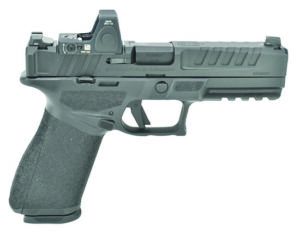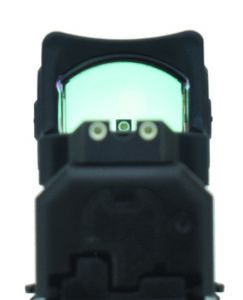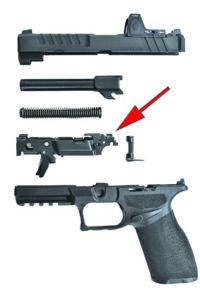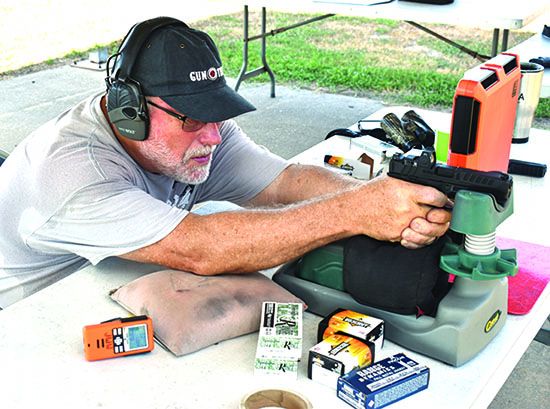Most of the law-enforcement officers on the street must face their challenges with nothing more than their training, experience, courage and the handguns on their hips. Those pistols have to go bang every time, and they have to hit what they are pointed at. Glock stills rules a large part of that world with their simplicity, ruggedness, and competitive price. The company has maintained that position by listening to its customers and by issuing successive generations of Glock Perfection, each bringing incremental improvements to the platform.
We grabbed one of the company’s latest versions, the Glock Model 47 PA475S204MOS, $629, which has most of the components set up to allow them to interchange with other similarly-sized Glocks. Our test piece has the slide cut for their Modular Optical System, or MOS.
Our second test item is the SIG Sauer P320 RX 320F-9-B-RXP, $880, which includes the Romeo 1 Pro sight. A strong contender for the LEO market, this pistol is very similar to the winner of the Army’s recent MHS (Modular Handgun System) competition, using the same serialized Fire Control Unit and many of the same parts. We grabbed one of the latest models with the full-length frame, a dust cover long enough to hang just about any light on, a slide already milled for optical sights, and backup sights in case the optics fail.
Our last entrant is the even newer Springfield Armory Echelon EC9459B-3D, $650. Utilizing a separate Central Operating Group, a la the SIG, the Echelon also brings interchangeable grip modules to the table. Add in a very robust optics mounting system. and we would get to see if the Echelon could keep up with the SIG P320 and the latest Glock Model 47 at the range.
Both the Glock 47 and the Springfield Armory Echelon were shot using a Trijicon RMR Reflex sight (RM01-C-700600, $478). The model of the SIG P320 we chose comes with a SIG Sauer Romeo 1 Pro, $358, already mounted. Here’s what we found:
Springfield Armory Echelon EC9459B-U 9mm Luger
$650
Gun Tests grade: A-
Rob Leatham, longtime pro shooter for Springfield Armory, said that he would take the blame for the Echelon if things were wrong. We think we need to give him and their engineers credit instead. We found their new pistol to be loaded with good

| Action Type | Semi-auto, striker-fired |
| Overall Length | 7.9 in. |
| Overall Height w/o optic | 5.4 in. |
| Overall Height w/optic | 6.0 in. |
| Maximum Width | 1.31 in. |
| Weight Unloaded | 1.5 lbs. |
| Weight Loaded | 2.2 lbs. |
| Slide Material | Billet-machined carbon steel |
| Slide Retraction Effort | 15.0 lbs. |
| Receiver Material | Polymer |
| Finish | Melonite |
| Front Strap Height | 2.6 in. |
| Back Strap Height | 3.75 in. |
| Barrel Length | 4.5 in. |
| Grip Thickness (Maximum) | 1.20 in. |
| Grip Circumference | 5.6 in. |
| Magazines | (1) 17-round and (1) 20-round |
| Rear Sight | Two-dot night sight, drift adjustable |
| Front Sight | One-dot night sight, drift adjustable |
| Sight Radius | 6.5 in. |
| Trigger Pull Weight | 3.7 lbs. |
| Trigger Span | 2.85 in. |
| Safety | Trigger, firing pin block |
| Warranty | Limited lifetime for original owner |
| Telephone | (800) 680-6866 |
| Website | Springfield-Armory.com |
| Made In | U.S. |
Springfield Armory may not be the first company to introduce a modular handgun, but the release of their new Echelon pistol shows that they have embraced the concept hook, line, and sinker. We had the chance to grab one of the Echelon models equipped with their Variable Interface System for mounting a red dot sight. It ships with a black zipper case, 17-round flush fit and 20-round extended magazines, and three interchangeable backstraps.
The slide caught our eye immediately. Some of the options present were expected. The anticipated forward grasping grooves were there, but then Springfield added in what they call a trench angling into the rear of the grooves that help the shooter obtain a very solid grip for press checks. There are three grooves at the rear of the slide that culminate in flared wings, if you will, that make a slingshot-style grip on top of the slide a simple proposition.

Sights on our sample were metal, tall enough to view over the deck of the Trijicon sight, and mounted in dovetails, making them drift adjustable. Both have tritium inserts, making them visible at night. The rear sight is a tactical style with a sharp forward shelf, allowing the slide to be racked against a belt or other protuberance should the need arise. Except that there was a miniature red dot sight (MRDS) installed, so we would use that instead. Even viewing through the MRDS, the front sight settled in the rear U-notch, making a very good sight picture.
Then we saw two things we really liked in the optics mount. First is the location of the mount. Springfield made sure that the MRDS was located far enough forward to allow a real rear sight to stay installed, even when the red dot was on board. This allows for a very nice set of backup iron sights. Second is the mount itself. Springfield calls it a Variable Interface System, and it provides some of the functionality we have been begging for. With the red dot removed, the user finds a number of holes that fit a variety of sight footprints, not just a select few. Many modern sights have holes in their base that act as a sort of recoil lug. Set the sight on the posts, and everything is supposed to lock down tight.
Springfield designed two front posts that pivot a bit when the sight is tightened down, thus pinching in on the sight. It worked for us as we tested using a Trijicon RMR, and attachment was rock solid. Complete information on the pin sets used is available at Echelon Complete Pin Set for VIS (Variable Interface System) on Springfield-Armory.com.
The grips contained more surprising features. As does the SIG Sauer P320, the Echelon puts all of the fire-control parts into a stand-alone unit they call a Central Operating Group, or COG. This is the serialized part and can easily be changed to other configurations. Our Echelon came to us mounted in a medium-sized grip module, while small and large are also available. We obtained the small unit and changed it out. The procedure for doing so is much like that of the SIG P320, with one real exception. The Echelon has a hook that must be captured by the flat side of the takedown latch. There were several pauses and muttered expletives until we figured that out.

We told you we liked the Adaptive Grip Texture when we tested their Hellcat pistol, and Springfield put it on this pistol as well. Essentially a double layer of texturing, a relaxed grip touches the first level and keeps the pistol in the hand. If the shooter grips the pistol tightly, they encounter the second level, which assured a good grip for us even in some very warm weather. Not only does the texturing wrap all the way around the grip, but it is also extended to other points on the pistol. There are textured index points on both sides of the pistol where the pad of a thumb in a thumb-forward grip should rest. The bottom of the well-undercut trigger guard is textured. Even the front of the recoil-spring assembly is textured — not real sure about that one. The dust cover has a Picatinny rail with four transverse slots. The magazine release is not reversible; it is truly ambidextrous, with releases on both sides.
A simple touch we liked was the slide release. Most polymer pistols we’ve handled recently have stamped slide stops/releases that protrude from the side of the slide and then curve downward. We have found many of these to be problematic for the times when we want to do a speed mag change and then release the slide with the thumb. It can tend to just roll on down the release.
The Echelon, in contrast, has stamped pieces that protrude and then end before the downward turn. This provides a nice shelf we could consistently hit and activate with our thumb — either thumb you choose since that is also ambidextrous. Add in the beveled magwell and the molded-in flats that allow the shooter to grab a sticky magazine, and we were quite pleased with the handle on this Springfield pistol.
The mechanics on the Echelon are also worth noting. The trigger is completely pre-tensioned (or cocked), allowing a short, light trigger pull. Initial take up measured less than 0.25 inch on our sample. Required movement after we reached the pressure wall was less than that. Don’t worry, Springfield Armory added in a secondary sear to make sure that everything was safe. The trigger shoe is flat and fairly wide. The safety blade located in the trigger, under compression, retracts to a point where it is flush with the trigger shoe. The effect is a single smooth surface without any ridge to affect trigger press or irritate the trigger finger.
As with the SIG P320 and the Glock 47, the Echelon functioned perfectly through several hundred rounds, with us holding the pistol every which way we could just in case it wanted to mess up. It shot the Remington and Fiocchi ammo fine, but let us know quickly it didn’t like the Armscor 124-grain JHPs. Those results dropped the Echelon down to third place in the accuracy standings, a mere 0.17 inch behind the Glock and only 0.4 inch back of the SIG. We dropped it half a grade for that.
Our Team Said: Accuracy notwithstanding, we were impressed with what Springfield has done with their new pistol. The speed drills saw the Echelon finish in second place, a few hundredths of a second behind the SIG. Perhaps the difference was the testers. The Echelon has a grip angle much closer to the Glock than the SIG. We practiced at it, but it took us just a hair longer to find the sight on the Springfield and the Glock. All three pistols shot well, and we wouldn’t hesitate to carry any of them.
| 9MM LUGER RANGE DATA | |||
| Remington 115-grain FMJ | Glock Model 47 | SIG Sauer P320 | Springfield Armory Echelon |
| Average Velocity | 1142 fps | 1149 fps | 1157 fps |
| Muzzle Energy | 333 ft.-lbs. | 337 ft.-lbs. | 342 ft.-lbs. |
| Best Group Size | 1.44 in. | 1.19 in. | 1.23 in. |
| Average Group Size | 1.75 in. | 1.43 in. | 1.42 in. |
| Armscor 124-grain JHP | Glock Model 47 | SIG Sauer P320 | Springfield Armory Echelon |
| Average Velocity | 1127 fps | 1164 fps | 1162 fps |
| Muzzle Energy | 350 ft.-lbs. | 373 ft.-lbs. | 372 ft.-lbs. |
| Best Group Size | 1.03 in. | 0.69 in. | 1.16 in. |
| Average Group Size | 1.17 in. | 1.17 in. | 2.06 in. |
| Fiocchi 147-grain FMJ | Glock Model 47 | SIG Sauer P320 | Springfield Armory Echelon |
| Average Velocity | 952 fps | 960 fps | 978 fps |
| Muzzle Energy | 296 ft.-lbs. | 301 ft.-lbs. | 312 ft.-lbs. |
| Best Group Size | 1.03 in. | 0.82 in. | 0.90 in. |
| Average Group Size | 1.27 in. | 0.92 in. | 1.24 in. |
How we tested: We conducted our tests at American Shooting Centers in Houston. At 15 yards, we fired multiple five-shot groups for accuracy by shooting from a well-sandbagged Caldwell Pistolero shooting rest (MidwayUSA.com 517357, $28) assisted by a Mini DRC Fortune Cookie from Wiebad.com ($75, #MINIFC). We also wanted to test practical accuracy, so we did two additional tests. The first used 3-by-5-inch stickies attached to paper targets 8 yards downrange. We recorded first-shot times using 115-grain ammo. Then we shot controlled pairs (two sights with two sight pictures) also at 8 yards and using the same 3-by-5-inch targets. The third was a single shot on an A Zone plate (5-by-11 inches) at 32 yards. Start position on all drills was from the low ready. We used a LabRadar (MyLabRadar.com, $559) to obtain velocities using three different types of ammunition. The first was Remington Range 115-grain full-metal-jacket rounds. Then we tried Armscor 124-grain FMJs and some heavier-weight bullets using the Fiocchi Range Dynamics 147-grain FMJs.
| DRILL NO. 1 DATA | |
| Pistol | Single Shot Average Time |
| Glock Model 47 | 0.93 |
| SIG Sauer P320 | 0.82 |
| Springfield Echelon | 0.89 |
Process: Fire one shot from low ready at 3-by-5-inch card placed at 15 yards. Numbers are averages for eight repetitions. Times are in seconds.
| DRILL NO. 2 DATA | |||
| Pistol | 1st Shot | Split Average | Total Time |
| Glock Model 47 | 1.01 | 0.21 | 1.22 |
| SIG Sauer P320 | 0.92 | 0.178 | 1.098 |
| Springfield Echelon | 0.86 | 0.183 | 1.043 |
Process: Fire two shots from low ready at 3-by-5-inch card placed at 8 yards. Numbers are averages for four repetitions. Times are in seconds.
| DRILL NO. 3 DATA | |
| Pistol | Single Shot Average Time |
| Glock Model 47 | 1.27 |
| SIG Sauer P320 | 1.12 |
| Springfield Echelon | 1.26 |
Process: Fire one shot from low ready at 5-by-11-inch A-Zone target placed at 32 yards. Numbers are averages for four repetitions. Times are in seconds.
Written and photographed by Joe Woolley, using evaluations from Gun Tests Team members. GT




























